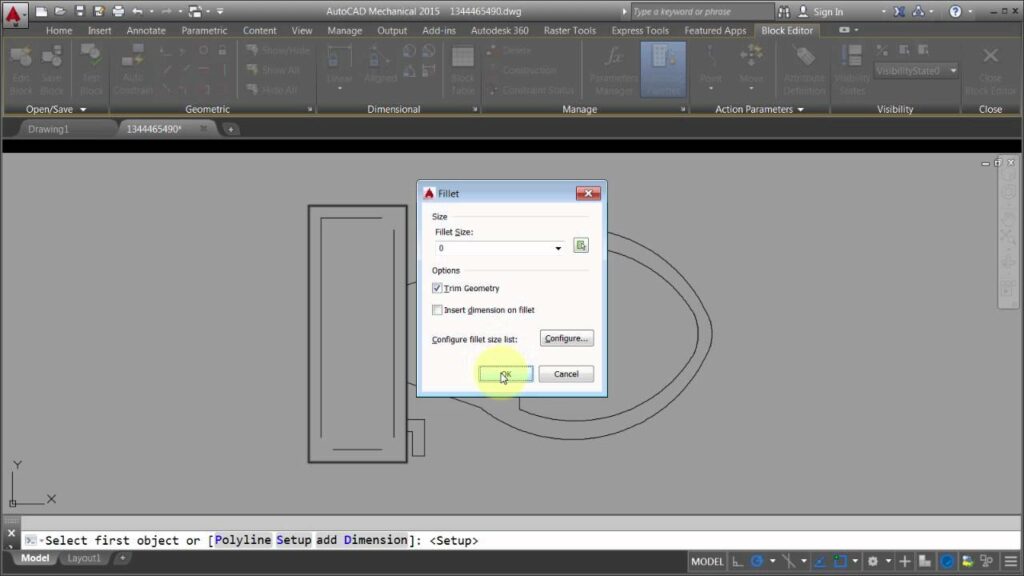Blueprint Brilliance: Crafting Complex Designs with AutoCAD’s Block Editor

Introduction:
AutoCAD stands as a cornerstone in the realm of Computer-Aided Design (CAD), offering a robust set of features that empower designers to bring their visions to life. Among these features, the AutoCAD Block Editor stands out as a powerhouse tool, enabling users to create, modify, and manage dynamic blocks. In this comprehensive guide, we will embark on a journey to explore the intricacies of the AutoCAD Block Editor, unraveling its functionalities, applications, and providing a roadmap for elevating your proficiency in creating and manipulating dynamic blocks.
Section 1: Understanding the Essence of AutoCAD Block Editor
Defining Dynamic Blocks:
Dynamic blocks in AutoCAD go beyond static elements, allowing designers to create intelligent, parametric objects. These blocks can adapt to different configurations, sizes, and orientations, enhancing flexibility and efficiency in the design process.
The Role of Block Editor:
The AutoCAD Block Editor serves as the gateway to the world of dynamic blocks. It provides a dedicated environment for designing and editing the parameters, actions, and visibility states that define the dynamic behavior of blocks. By mastering the Block Editor, designers gain unparalleled control over the adaptability and intelligence of their block libraries.
Section 2: Activating the Block Editor
Step 1: Opening Block Editor:
To access the Block Editor, users can either double-click on a block within the drawing or use the “BEDIT” command. This action opens a dedicated workspace where users can modify the block definition.
Step 2: Navigating the Block Editor Interface:
The Block Editor interface consists of specific tabs and panels tailored for block editing tasks. Familiarizing yourself with these elements ensures a smooth transition into the world of dynamic block creation and manipulation.
Section 3: Creating Basic Blocks
Step 1: Designing Base Geometry:
The foundation of a dynamic block starts with the creation of its base geometry. Users can draw the essential elements that will form the core of the block, such as lines, circles, or rectangles.
Step 2: Defining Block Attributes:
Block attributes add intelligence to the block, allowing for dynamic text or data input. By defining attributes, users can create blocks that adapt to different informational requirements, enhancing the versatility of the design.
Section 4: Introduction to Parameters
Understanding Parameters:
Parameters act as the variables that govern the dynamic aspects of a block. In the Block Editor, users can define parameters to control the size, rotation, or visibility of block elements, transforming static geometry into adaptive components.
Types of Parameters:
AutoCAD offers various parameter types, including linear, polar, and XY parameters. Each type serves a specific purpose, providing designers with a comprehensive toolkit for creating dynamic relationships within their blocks.
Section 5: Actions and Dynamic Behavior
Defining Actions:
Actions are the responses or behaviors linked to parameters. In the Block Editor, designers can specify how the block elements should react when parameters change. This can include stretching, rotating, or hiding specific components based on user-defined conditions.
Dynamic Block Test:
The Block Editor allows users to test their dynamic blocks within the editing environment. This iterative process ensures that the defined parameters and actions produce the desired dynamic behavior before implementing the block in the main drawing.
Section 6: Visibility States
Understanding Visibility States:
Dynamic blocks often involve components that may appear or disappear based on specific conditions. Visibility states allow designers to create variations within a block, controlling the visibility of individual elements to accommodate different design scenarios.
Creating Visibility States:
In the Block Editor, designers can define and customize visibility states, specifying which components should be visible or hidden under different conditions. This feature adds an additional layer of adaptability to dynamic blocks.
Section 7: Advanced Parameter Techniques
Parameter Sets:
Parameter sets enable users to define specific configurations for a block by grouping related parameters. This allows for the creation of more complex and organized dynamic block structures.
Lookup Tables:
Lookup tables provide a systematic way to assign values to parameters, facilitating precise control over block behavior. This feature is particularly useful for managing specific design standards or ensuring consistency across different blocks.
Section 8: Actions and Parameter Constraints
Action Relationships:
Advanced dynamic blocks often involve complex relationships between parameters and actions. By establishing relationships, designers can create blocks that respond intelligently to user inputs, maintaining a cohesive and controlled design experience.
Parameter Constraints:
Constraints add an additional layer of control to dynamic blocks by restricting certain parameters within defined limits. This ensures that block behavior remains within specified boundaries, preventing unintended distortions or errors.
Section 9: Sharing Dynamic Blocks
Saving Dynamic Blocks:
Once the dynamic block is perfected within the Block Editor, designers can save the changes to the block definition. This updated block can then be used across different drawings, maintaining its dynamic properties.
Design Center and Tool Palettes:
AutoCAD provides tools like Design Center and Tool Palettes for managing and sharing dynamic blocks across projects. These features enhance collaboration and consistency in design workflows.
Section 10: Tips for Optimal Block Editor Mastery
Tip 1: Plan Before You Edit:
Before entering the Block Editor, it’s crucial to have a clear plan for the dynamic behavior and configurations you want to achieve. This strategic approach ensures a more efficient editing process.
Tip 2: Utilize Grips Efficiently:
Grips in the Block Editor provide a quick and intuitive way to manipulate block geometry. Understanding how to leverage grips enhances the overall efficiency of block editing.
Section 11: Troubleshooting Block Editor Issues
Issue 1: Unexpected Behavior:
If a dynamic block exhibits unexpected behavior, revisit the parameters and actions within the Block Editor. Ensure that the relationships are defined correctly and that there are no conflicting actions.
Issue 2: Inconsistent Visibility:
For visibility-related issues, inspect the visibility states and their conditions. Verify that the defined conditions accurately represent the scenarios under which specific components should be visible or hidden.
Section 12: Saving Time and Boosting Productivity
Step 1: Streamlining Design Processes:
By mastering the Block Editor, designers can streamline their design processes, creating intelligent blocks that adapt seamlessly to various design scenarios. This efficiency translates to time savings and enhanced productivity.
Step 2: Precision Unleashed:
As users become adept at leveraging the AutoCAD Block Editor, they unlock a realm where design precision is not just a goal but a constant companion throughout the design journey. Dynamic blocks, when harnessed effectively, elevate design flexibility, intelligence, and adaptability.
Conclusion:
The AutoCAD Block Editor emerges as a powerhouse within the CAD landscape, providing designers with the tools to create intelligent, adaptable, and parametric blocks. This comprehensive guide has navigated the intricate landscape of the Block Editor, from its activation and interface to the creation of dynamic parameters, actions, and visibility states. As you embark on your journey to master the art of dynamic block creation and manipulation, let the Block Editor be your gateway to a new era of design precision and efficiency. Embrace the dynamic possibilities, embrace the precision – let AutoCAD’s Block Editor redefine the way you approach and execute your CAD designs.




